–
重訂崩步拳
AVALANCHE STEPS BOXING SET (REVISED)
順德黃漢勛編述
by Huang Hanxun [Wong Honfan] of Shunde
山東蓬萊羅師光玉授及遺照示範
as taught by Luo Guangyu of Penglai, Shandong
(and featuring photos of him demonstrating the set)
[published in Hong Kong, 1955]
[translation by Paul Brennan, Jan, 2020]
–
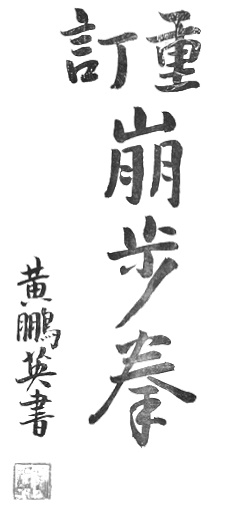
重訂崩步拳
Avalanche Steps Boxing Set (Revised)
黃鵬英書
– calligraphy by Huang Pengying
–
論崩步
DISCUSSING THE AVALANCHE STEPS BOXING SET
崩步乃螳螂拳之第二基本拳,全拳凡四十七式,惟螳螂拳之練法與別派有異,連貫一致,全路呵成,發手盡勁,是其別點,與夫每拳輒百餘式,或數百式者不同,螳螂拳以八剛十二柔為原則,惟崩步是基本拳,故側重剛手,取其易習也,客有問余曰:螳螂拳出手輒(迫卜)作响,或左右手相碰者,作何理解?余乃憶及每到一地,各同志多以此為詢,今藉此機會當為釋之,按螳螂拳出手,放盡腰馬拳腿,若練技未深者,全身每被牽動,以至浮蕩不定姿勢傾斜,假若左拳打出,而以右掌抵之,可使左拳伸出準繩,勁達定點,重心鞏固,是其練技時之特處,亦卽所以防其缺也,至两手相碰之意欲互增其力也,或作另一解釋,則左手出以右手為假想敵,右手亦如之,目標旣集變化自易,斯為螳螂拳之主張,非祗崩步一拳如是也,崩步出手簡潔,左右平衡,虛實相等,最適合於團體敎練,蹤躍跌蕩兼而有之,倘能練之純熟,可作兩人相對,全路手法腿法盡量解拆,旣能使習者得了解功用又可作登台表演,羅師嘗言:螳螂拳皆可如是對拆,惟崩步尤能作三種解法,一曰:領,二曰:劈,三曰:拆,,領者,領會其全路動作,每式之功用,均作迎拒之勢,使盡量表現其拳法之眞諦,劈者,由反面而出,按法演進,比之領會更切實用,拆者,分式解拆,不能連貫為用,由一式而化出別式,以一脚而牽及他脚,總言之,領是知其意劈是實其用,拆而解之變化萬端矣。
Avalanche Steps is the second basic set in Mantis Boxing [after Fourteen-Line Tantui], comprised of forty-seven postures. The practice methods of Mantis Boxing are different from other styles. It has to be performed as a continuous flow from beginning to end and yet with the hands fully expressing power throughout, a quality that makes it noticeably different from boxing sets of other arts even though they may be comprised of hundreds of postures. Mantis Boxing involves both hardness and softness, but because Avalanche Steps is a basic boxing set, it therefore emphasizes techniques of hardness, which are easier to learn.
A visitor once asked me: “Why do the hands audibly strike against each other in the movements of Mantis Boxing?” Thinking back to the various comrades who have asked the same question, I feel I should now take this opportunity to explain. Mantis Boxing techniques fully express with the waist, stance, fists, and legs. If you have not yet trained to a deep enough level, your movements will affect your whole body and you will float around in the air unstably, leaning all over the place. If your left fist strikes out and your right palm braces against its forearm, this can increase the precision of your left fist, focusing power at its final position without affecting your balance as it does so. Practicing in this way thus prevents many flaws. Although the basic purpose of having the hands strike against each other is to increase power, another explanation is that when one hand strikes out, the other hand plays the role of the opponent, supplying a target for it. Such hand-striking is a constant feature in the boxing sets of Mantis, not just in Avalanche Steps.
The techniques in Avalanche Steps are succinct and uncomplicated, addressing both the left and right sides equally, alternating well between feints and real attacks, and is comprised of both leaping actions and flowing footwork. It is therefore ideal for group practice. In fact once it has been practiced to the point of skillfulness, it can then be performed with a partner. The entire set, every hand technique and every leg technique, will thus be fully realized, enabling the practitioner to understand how it is all to be applied. This also provides a spectacle that can be performed before an audience.
Master Luo once said: “Mantis Boxing sets can all be practiced as partner sets, and Avalanche Steps in particular can help you get used to the three ways of doing this: understanding, dividing, and deconstructing.”
1. “Understanding” means going through the entire set, every movement and every posture, defending against attacks, thereby fully revealing the true essence of the techniques.
2. “Dividing” means playing the other role [i.e. being the attacker for the person who is performing the set to respond to], which produces an even more refined awareness of how the techniques in the set are applied.
3. “Deconstructing” means to work on the individual techniques rather than all of them linking together, and in this way a technique can lead into a completely different technique or a stance can change into a completely different stance [instead of being forever bound to the pre-programmed choreography of the set].
To sum up: understanding lets you know the purpose of each movement, dividing solidifies its function, and deconstructing leads to endless transformation.
–
崩步拳形勢圖
Map for the Avalanche Steps boxing set:
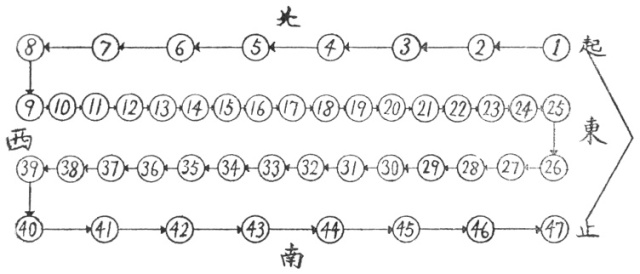
N
北
W 西 東 E
南
S
起
begin
止
finish
–
中平雙蓄勢
[1] STANDING STABLY, BOTH FISTS STORING POWER
跨虎斜補捶
[2] SITTING-TIGER STANCE, DIAGONAL FILLING PUNCH
跨虎捕蟬式
[3] SITTING-TIGER STANCE, CATCHING A CICADA
登山左揷掌
[4] MOUNTAIN-CLIMBING STANCE, LEFT CHARGING PALM
登山右補捶
[5] MOUNTAIN-CLIMBING STANCE, RIGHT FILLING PUNCH
縱跳封統捶
[6] LEAP, SEAL & THRUST PUNCH
入環右叠肘
[7] KNEELING STANCE, RIGHT PILING ELBOW
入環右崩捶
[8] KNEELING STANCE, RIGHT AVALANCHE PUNCH
背踢雙撥掌
[9] KICK BEHIND, DOUBLE DEFLECTING HANDS
馬式雙封手
[10] HORSE-RIDING STANCE, DOUBLE SEALING HANDS
登山刁劈捶
[11] MOUNTAIN-CLIMBING STANCE, HOOKING HAND, CHOPPING PUNCH
右抅摟採手
[12] RIGHT HOOK & PULL SEIZING
跨虎番車式
[13] SITTING-TIGER STANCE, WHEELING TECHNIQUE
登山左揷掌
[14] MOUNTAIN-CLIMBING STANCE, LEFT CHARGING PALM
登山右補捶
[15] MOUNTAIN-CLIMBING STANCE, RIGHT FILLING PUNCH
馬式雙封手
[16] HORSE-RIDING STANCE, DOUBLE SEALING HANDS
登山右腰斬
[17] MOUNTAIN-CLIMBING STANCE, RIGHT SLICING THROUGH THE WAIST
馬式左崩捶
[18] HORSE-RIDING STANCE, LEFT AVALANCHE PUNCH
提腿左刁手
[19] LIFTING LEG, LEFT HOOKING HAND
提腿反提刁
[20] LIFTED LEG, REVERSE LIFTING HOOK
馬式右劈軋
[21] HORSE-RIDING STANCE, RIGHT CRUSHING CHOP
扭步左黏肘
[22] TWISTING STANCE, LEFT STICKY ELBOW
登山左拐肘
[23] MOUNTAIN-CLIMBING STANCE, LEFT PROPPING ELBOW
登山右斜掌
[24] MOUNTAIN-CLIMBING STANCE, RIGHT DIAGONAL PALM
馬式正補捶
[25] HORSE-RIDING STANCE, FORWARD FILLING PUNCH
雙刁左揪腿
[26] DOUBLE HOOKING, LEFT SCOOPING KICK
雙刁右揪腿
[27] DOUBLE HOOKING, RIGHT SCOOPING KICK
跨虎雙捆手
[28] SITTING-TIGER STANCE, DOUBLE SNARING HANDS
踢腿刁取眼
[29] KICK, JAB TO THE EYES
提腿相擊手
[30] LIFTING LEG, STRIKING THE PALMS TOGETHER
刁手反衝爪
[31] HOOKING HAND, REVERSE THRUSTING CLAW
拚腿上圈捶
[32] LEGS TOGETHER, RISE UP, SWINGING PUNCH
提腿下截捶
[33] LIFTING LEG, DOWNWARD INTERCEPTING FIST
提腿上挑手
[34] LIFTED LEG, CARRYING FIST
登山封齊掌
[35] MOUNTAIN-CLIMBING STANCE, SEALING, EQUALIZING PALM
反封左措捶
[36] REVERSE SEALING, LEFT TWISTING HIS FIST
迎封右措捶
[37] BLOCK & SEAL, RIGHT TWISTING HIS FIST
掛手頂臍捶
[38] HANGING HAND, PUNCH TO THE NAVEL
吞塌右扇風
[39] GULP & SINK STANCE, RIGHT FANNING
吞塌左扇風
[40] GULP & SINK STANCE, LEFT FANNING
吞塌右扇風
[41] GULP & SINK STANCE, RIGHT FANNING
引針右腰斬
[42] DRAWING THE NEEDLE, RIGHT SLICING THROUGH THE WAIST
登山左圈捶
[43] MOUNTAIN-CLIMBING STANCE, LEFT SWINGING PUNCH
登山左崩捶
[44] MOUNTAIN-CLIMBING STANCE, LEFT AVALANCHE PUNCH
七星左刁手
[45] BIG-DIPPER STANCE, LEFT HOOKING HAND
七星右補捶
[46] BIG-DIPPER STANCE, RIGHT FILLING PUNCH
跨虎捕蟬式
[47] SITTING-TIGER STANCE, CATCHING A CICADA
–
第一式:中平雙蓄勢
Posture 1: STANDING STABLY, BOTH FISTS STORING POWER
說明:
Explanation:
兩足靠櫳,站定東方,首偏向西,雙目注視,兩手握拳放腰部,拳鋒向外,拳心朝上,拳鋒與體平衡,閉口蓄氣,以養拳神。
With your feet together, stand in the eastern part of the practice space, your head turned toward the west. Your hands grasp into fists and are placed horizontally at your waist, turned outward so the centers of the fists are facing upward. Close your mouth, store your energy, and focus your attention. See photo 1:
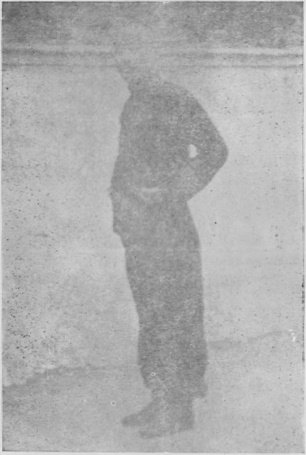
功用:
Application:
假定此拳,由東而西,由西復東為經緯,則起首之處為東方,故須注視西方,以防敵人由西侵我,緊握雙拳使其力固,準備攻擊之開始,此為待勞之勢也。
This set travels from east to west, then west to east, and thus the starting point is in the east with the head looking to the west. An opponent charges toward me from the west, so I make tight fists to fill myself with power and prepare for his attack. This is a posture of “using leisure to await the enemy’s exhaustion” [Art of War, chapter 7].
第二式:跨虎斜補捶
Posture 2: SITTING-TIGER STANCE, DIAGONAL FILLING PUNCH
說明:
Explanation:
邁開左步,平向後移約一尺二寸,右足向前踏出,成三角線,變步為跨虎式,右拳由腰間發出,將至定點之時,使與左掌相碰,互增力量,此為本門拳術之特式。
Your left foot steps out to the rear, shifting about a foot and a quarter, then your right foot steps out forward to make a sitting-tiger stance, your feet making a triangle shape, as your right fist shoots out from your waist, forcefully smacking against your left palm on the way. This is a characteristic posture of Mantis Boxing. See photo 2:

功用:
Application:
當敵以上門手進擊時,我偏首卸之,移步換形以反擊之,其拳將到時,我先以左掌向其臂肘拍去,乘便施以海底取珠之法,使難防備,斯為偷打之法,亦卽連招代打捷徑之一也。
An opponent sends out a hand to strike to my upper area, so I turn my head toward him, shift my feet, and change my position in order to counter his attack. Before his punch arrives, I first use my left palm to slap away his arm at the elbow area, then continue right into the action of “snatching a pearl from under the sea”, making it difficult for him to defend against my counterattack. This is a method of sneaking in a strike, a quick means of switching from defense to attack.
第三式:跨虎捕蟬式
Posture 3: SITTING-TIGER STANCE, CATCHING A CICADA
說明:
Explanation:
前步退囘原位,左腿補其位置,其來往之法亦三角形,變為左跨虎式,將取珠之手沉下,使兩手交柯轉而上下圈返,以封閉來手,前手與體為一齊線,後手貼身沉肘,則螳螂補蟬之法成矣。
Your right foot retreats back to where it was and your left foot adjusts its position to make another sitting-tiger stance, your feet again forming a triangle shape, as your hands sink down and circle back upward [drawing a counterclockwise arc] to seal off the opponent’s incoming hand, your left hand in line with your body, your right hand sinking its elbow closer to your body, thereby forming the “catching a cicada” position. See photo 3:
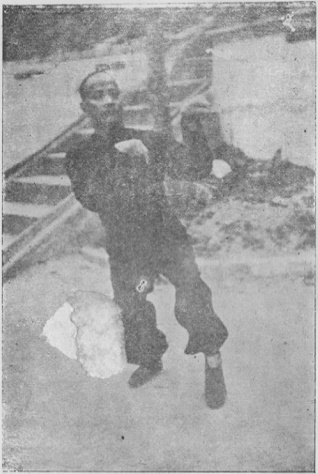
功用:
Application:
斯為虛着,亦卽純柔之手,形類擒拿,實為虛實無定之法門,倘對方力求解脫之時,我則縱之,順起前腿以撩其陰,故其着手處,實無牢固之必要。
This technique is a feint, involving pure softness. It appears to be an action of seizing, but is not actually a technique in its own right. When the opponent strives to free himself from it, I let him go, but then I follow him by lifting my front foot and delivering a raising kick to his groin. This “catching a cicada” position itself is therefore not truly necessary.
第四式:登山左揷掌
Posture 4: MOUNTAIN-CLIMBING STANCE, LEFT CHARGING PALM
說明:
Explanation:
將前跨虎之步向前放下,後腿貼近前腿,猛力踏下,前腿續前進為登山式,此是由後推進之法,左手從腰際伸出,大指緊彎,其餘四指順序微彎。
Your left foot goes forward, your right foot follows and forcefully stomps right behind it, then your left foot continues forward to make a mountain-climbing stance, these actions being a method of charging forward, and your left hand reaches out from your waist, the thumb tight against the hand, the fingers slightly bent. See photo 4:
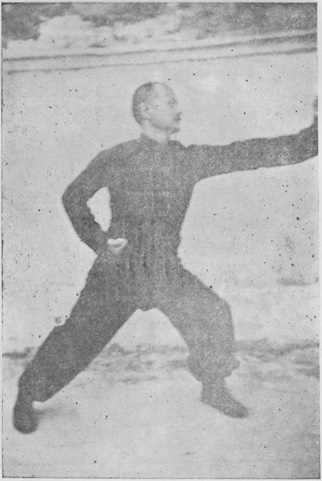
功用:
Application:
踏進者遠取之意也,倘若敵方遙遙距離,吾欲攻之,若非踏進則難奏效,其用掌須指向上,從側揷出,若刀之形狀,則着力處可盡吾之所有矣。
If I wish to attack the opponent once he is farther away, I have to charge forward in order to do so. When my palm charges forward, the fingers have to be pointing upward and the edge of the palm should be emphasized, making a shape like a blade, and thus all of my power will be expressed at that point.
第五式:登山右補捶
Posture 5: MOUNTAIN-CLIMBING STANCE, RIGHT FILLING PUNCH
說明:
Explanation:
後右脚從後上一步,變為右登山式,右拳從腰間打出,沿左掌擦過,左掌收囘右肩前,以換囘推窗之法,斯為換步移勢之捷法也。
Your right foot steps forward to make a right mountain-climbing stance as your right fist strikes out from your waist, scraping along your left palm, which is withdrawing it front of your right shoulder. This technique is a quick method of switching feet and shifting position. See photo 5:
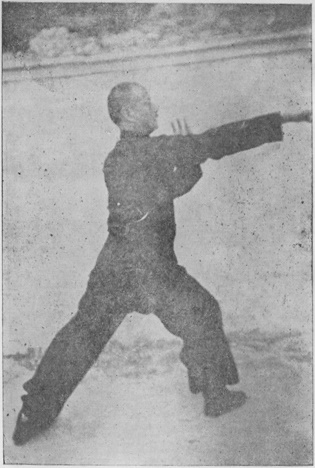
功用:
Application:
我以推窗法襲擊,右面感受空虛,設為敵所乘,由招吾推窗之頃刻,突從右方擊進,則吾勢危殆,乃有補捶之為用,是補其漏洞也,因勢利導,先以前掌向右一拍,補捶繼而出之,可補吾缺。
When I suddenly attack with an action of “pushing open a window”, this makes my right side vulnerable, which gives the opponent an opportunity to exploit. In this moment, he therefore attacks my right side, putting me in a dangerous situation, and thus I use a filling punch to plug the leak. Acting in accordance with the situation, I first use my left hand to slap away his hand to the right, then send a filling punch to fill the resulting gap.
第六式:縱跳封統捶
Posture 6: LEAP, SEAL & THRUST PUNCH
說明:
Explanation:
凡欲跳前須先提後脚,前脚一翹,身向上一縱卽能躍進,愈遠愈佳,落地無聲且成獨立式,右手前封若摟手無異,同時以左拳迎面打出。
Pulling in your left foot and raising your right foot, and with your body rising up, leap forward, the farther the better, landing soundlessly making a one-legged stance, as your right hand seals and pulls back and your left fist goes out with a strike to the face. See photo 6:
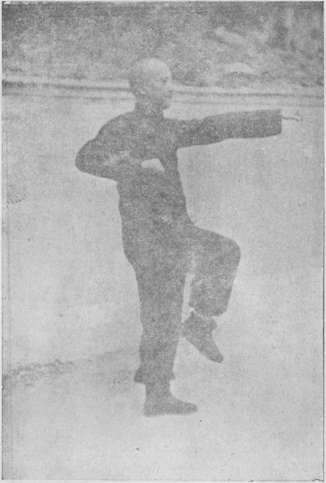
功用:
Application:
捨近圖遠是不智極矣,然偏因環境造成,不得不爾也,上式之漏洞旣補,但敵殊巧妙,以遠招之法破我,我卽縱身直往使難躱避免,前手一封,乘牽纏之勢,則我左拳可施突擊,亦抓打之法也。
It is not wise to abandon what is close at hand and instead seek what is far away, but sometimes the situation leaves us with no alternative. The opponent is clever and moves far away from my filling punch before it can reach him, so I leap toward him to make it harder to get away than he thought, my right hand at the same time sealing and pulling in, and my left fist should now be able to reach him, my hands using a method of “grab and strike”.
第七式:入環右叠肘
Posture 7: KNEELING STANCE, RIGHT PILING ELBOW
說明:
Explanation:
前腿踏下,如登山之微曲,後腿踝離地沉下,是為入環,欲前可為登山式,欲退則七星,中式皆可,是善變之步法也,以左掌從下托上,右手曲肘壓下,使兩手接觸相碰之時辟拍有聲為合。
Your right foot comes down as though to make a mountain-climbing stance, but instead your left leg bends and the heel lifts off the ground, making a kneeling stance (a changeable stance from which you could go forward to make a mountain-climbing stance or retreat to make a big-dipper stance or centering stance) as your left palm props up from below and your right elbow bends and presses down, slapping together with an audible crack. See photo 7:

功用:
Application:
叠肘乃純剛之手,多由上反下之法,左手力捉其腕,迅卽加右肘於其臂肘之上,使受吾千鈞壓力,無由卸却,是為破骨千斤之要着。
The piling elbow is a technique involving hardness, usually going downward from above. My left hand forcefully grabs the opponent’s left wrist and then I immediately add my right elbow on top of his left elbow, causing him to feel the pressure of a heavy weight that he cannot escape from. This is a technique of “crushing bone with a thousand pounds”.
第八式:入環右崩捶
Posture 8: KNEELING STANCE, RIGHT AVALANCHE PUNCH
說明:
Explanation:
步如上式,左手仍握着敵手,反以叠下之拳甲內向外,迎面打下,崩步至此式為甲東而西之第一節盡處。
With your stance not changing, and with your left hand still grasping the opponent’s hand, your right fist rolls over outward from inside to strike downward to the opponent’s face. This is the final posture in the first section of the set, which has been traveling from east to west. See photo 8:
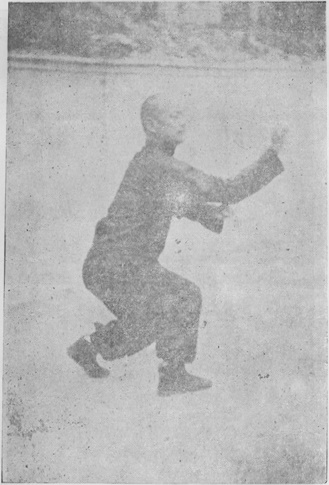
功用:
Application:
旣施叠肘之法,倘對方瞬卽沉肘相抗,吾若不立換形勢,徒費相持之力,故宜以叠下之肘反內抽出,就迎面崩下,是為裡外相應之法。
When I perform the piling elbow technique, the opponent suddenly sinks his elbow to resist against it, and so if I do not quickly switch my position, I will have expended effort only to get stuck in a stalemate. Therefore I should go from my piling elbow by whipping outward from inside, sending an avalanche punch crashing down upon his face. This is a method of an inward action and an outward action complementing each other.
第九式:背踢雙撥掌
Posture 9: KICK BEHIND, DOUBLE DEFLECTING HANDS
說明:
Explanation:
是式為本拳之第二節開端,卽由西復東之第一節也,先以後步站穩,右脚平放從後掃出,两手向左方同時撥去,惟其側身則有長短之分,短者消其來勢,長者與掃脚同出,上下呼應手脚齊施。
This is the first posture in the second section of the set, which will travel from west to east. Standing steady on your left foot, your right foot does a level sweeping kick behind you as your hands deflect toward the left, your right hand at short range to deflect an attack, your left hand at long range to counterattack in unison with your kicking foot, upper body and lower body working in concert. See photo 9:
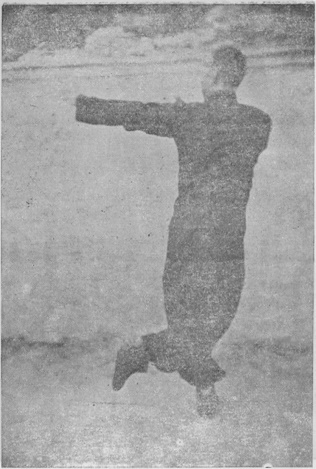
功用:
Application:
聲東擊西,圍魏救趙,斯為戰畧上之法則,亦兵行詭道是矣,攻前取後,使人有顧此失彼之效,如我祗顧向前攻取,突然偷襲吾後,則非反身圖救不可,掠翼之法可前可後,加之以軋膝之腿,當易奏功,亦攻守齊施之法也。
“Threatening to the east but then striking to the west” and “besieging Wei to rescue Zhao” are examples of military strategies that involve appearing to attack in one direction only to turn around and attack in another direction, having the effect of overwhelming the enemy. If I only ever focus on attacking forward, I will end up surprised by an attack from behind, and then I will be forced to turn around to save myself. The action of “swatting wings” has one hand forward and the other behind it, attacking and defending simultaneously, and is made even more effective by the addition of a crushing kick to the opponent’s knee.
第十式:馬式雙封手
Posture 10: HORSE-RIDING STANCE, DOUBLE SEALING HANDS
說明:
Explanation:
後軋出之脚退囘原地,成騎馬式,掠出雙掌力握來手,順勢牽來,由背面反為正面,使身離危境,易於攻守,佔有上風是也。
Your right foot retreats back to where it was to make a horse-riding stance as your palms grab the opponent’s incoming arm and pull in the direction of his momentum. With the opponent now in front of you rather than behind you, you are in a less dangerous and more advantageous position, from which you are able to easily attack or defend. See photo 10:

功用:
Application:
以背身相向能挽不敗足矣,安望佔得勝利?對方一提一讓,吾勢瓦解,若加以反擊,則非用封手牽羊之法不可,如敵人企圖以手由正門還擊之時,我卽退囘原步,封其手而牽纏就範。
My previous technique saves me from defeat, but how can I go further and achieve victory? The opponent lifts his leg and gets out of the way of my kick, making my attack evaporate. When he then counterattacks, there is nothing I can do except use the method of “sealing hands lead the sheep”. He tries to send out a hand to attack from directly in front of me, so I retreat, sealing off his arm, and pull on it.
第十一式:登山刁劈捶
Posture 11: MOUNTAIN-CLIMBING STANCE, HOOKING HAND, CHOPPING PUNCH
說明:
Explanation:
由騎馬式轉登山,左手向外刁出,右手以捶劈下,到相接之時,左手忽化為掌,力托劈下之拳,使定點準確,互增力量。
Switch to a mountain-climbing stance as your left hand hooks outward and your right fist chops downward, your left hooking hand then suddenly becoming a palm and propping up under your right forearm, forcefully coming together to their final position. See photo 11:
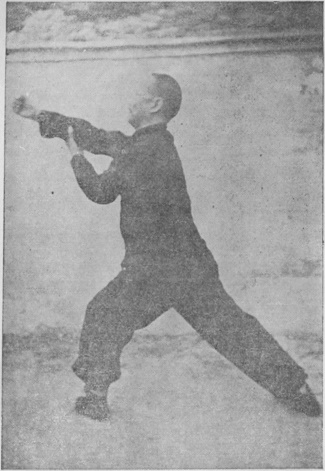
功用:
Application:
牽羊之法,祗封其一手耳!其餘一手隨時可向吾進攻者,其拳一來,吾卽移步轉為登山式,左手向上一迎,順勢一刁,則我泰山之勢,就其空間劈下,是為八剛之首也。
The previous action of “leading a sheep” deals with only one hand, meaning that the opponent’s other hand might attack me at any time. When he then punches at me, I immediately switch to a mountain-climbing stance while sending my left hand up to meet it and smoothly hook it away, thus opening the way for me to chop down toward him with the technique of MT. TAI CRUSHES THE HEAD, the first among the “eight kinds of hardness”.
第十二式:右抅摟採手
Posture 12: RIGHT HOOK & PULL SEIZING
說明:
Explanation:
沿上式不變,壓頂之手向外一刁,左手向裡一摟,同以一手為目標,後手代前手,接連三手,至末之一手,以捶打出,此為螳螂十二字要訣四份之一也。
With your stance not changing, your right hand hooks outward, your left hand pulls inward upon the same target, then your right hand goes forward. This continuous series of three hand actions forms a single technique, culminating in a punch. These three terms – “hook & pull seizing” – form a quarter of Mantis Boxing’s “twelve key terms”. See photo 12:
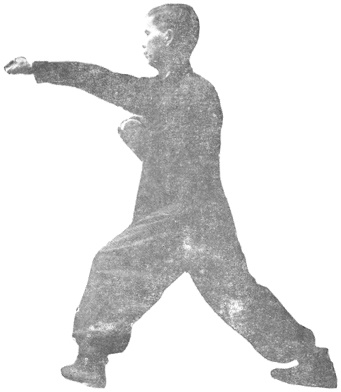
功用:
Application:
向外為刁,從裡為摟,接連不斷是為探,再加一拳,卽上乘之手法也,斯為螳螂拳法中之特有,由右而左,由左而右,綿亘不絕,纏繞難分,得機卽打。
There should be no interruption between hooking outward and pulling inward, and then the punch is added. This is one of the very best techniques and is a characteristic technique of Mantis Boxing. Whether it is performed moving right to left or left to right, it should be done as a continuous motion, an overall coiling pattern that makes the parts difficult for the opponent to distinguish. Once you have the opportunity, strike.
第十三式:跨虎翻車式
Posture 13: SITTING-TIGER STANCE, WHEELING TECHNIQUE
說明:
Explanation:
後脚踏前靠緊前脚,再開出前足,成跨虎式,右手擒緊敵手,向上一提,同時以左手沉肘,拳鋒反內向上力抽,兩拳須前後相對,角度進繩。
Your right foot stomps next to your left foot and then your left foot goes forward to make a sitting-tiger stance, your right hand grabbing the opponent’s hand and lifting it up, as your left elbow sinks and your left fist forcefully whips out upward from inside. Your fists should be aligned forward and back as though pulling a rope. See photo 13:
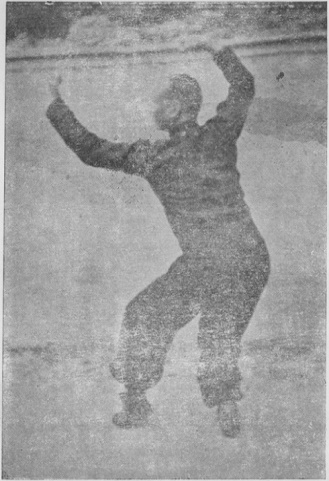
功用:
Application:
拳經云,翻車遠,而螳螂近,翻車速,而螳螂密,翻車之法頗多,有順翻,逆翻,斜翻,倒翻,是皆連續之翻,惟此式祗一翻便止。
It says in the boxing classics: “The wheeling technique reaches far, whereas the usual Mantis techniques draw near. The wheeling technique is done very fast, whereas the usual Mantis techniques put more emphasis on precision.” There are several kinds of wheeling techniques, including smooth wheeling, reverse wheeling, diagonal wheeling, retreating wheeling, and so on, all of which are to be performed as a continuous motion. This posture is just one variation.
第十四式:登山左揷掌
Posture 14: MOUNTAIN-CLIMBING STANCE, LEFT CHARGING PALM
與第四式相同祗方向各別耳。
Explanation: Same as in Posture 4, except in a different direction. See photo 14:

與第四式相同。
Application: Same as in Posture 4.
第十五式:登山右補捶
Posture 15: MOUNTAIN-CLIMBING STANCE, RIGHT FILLING PUNCH
與第五式相同祗方向各別耳。
Explanation: Same as in Posture 5, except in a different direction. See photo 15:
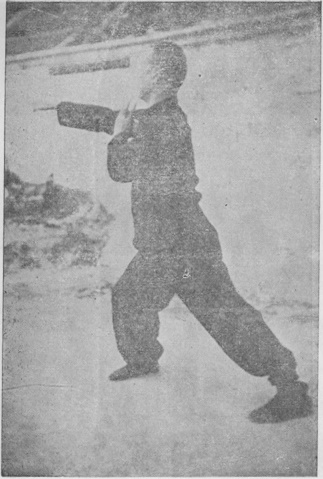
與第五式相同。
Application: Same as in Posture 5.
第十六式:馬式雙封手
Posture 16: HORSE-RIDING STANCE, DOUBLE SEALING HANDS
說明:
Explanation:
定式與第十式無異,惟其分別之處,則前者從後抽步而返。此乃由前撤步而囘者,先用右手封來手,繼以左手托其肘而拖囘
The final position is the same as in Posture 10 [and indeed reuses the photo], except that the situation is different, in the previous case involving the foot behind you withdrawing back into place, whereas in this case it is a matter of the front foot retreating as your right hand seals off the opponent’s incoming hand, your left hand props up his elbow, and you pull his arm in. See photo 16:
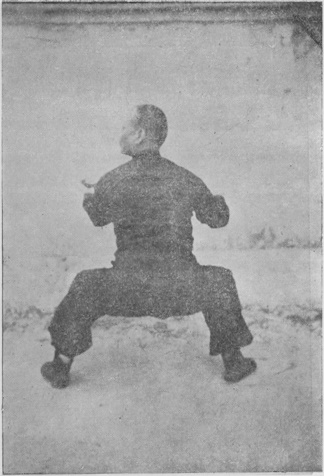
功用:
Application:
右手乘牽擒之勢力捉敵腕,左手向其肘底托上反而拏之,倒退一步,若敬酒之狀,取其意若强留人客一般神態也。
With my right hand tightly grabbing the opponent’s wrist and my left hand propping up and grabbing his elbow, I retreat a step. As though I am proposing a toast, I have the bearing of a host trying to keep a guest from leaving.
第十七式:登山右腰斬
Posture 17: MOUNTAIN-CLIMBING STANCE, RIGHT SLICING THROUGH THE WAIST
說明:
Explanation:
逢踏步但欲先振聲威,然後俟機進迫者,是式先力踏後步,替代前足,使能直抵敵陣,向後偷入,左手封閉來手,右手從腰部橫切,偷入之步復加一彈,彼則重心傾斜,為吾所乘矣。
First intimidate the opponent with sound and then take the opportunity to crowd in on him by forcefully stomping your right foot next to your left foot and advancing your left foot behind his front leg, at the same time using your left hand to seal off his incoming hand and sending your right hand from your waist to slice across to his. After sneaking your left foot past his front leg, add a snapping action [i.e. nudging your thigh inward against his front leg], causing his balance to destabilize and putting him in a position that you can take advantage of. See photo 17:
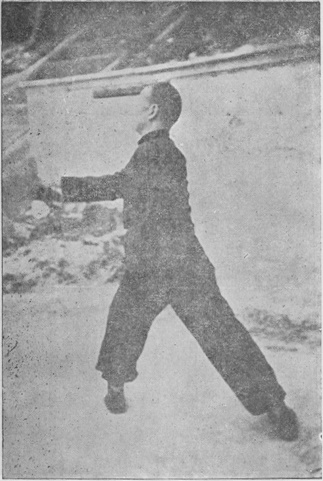
功用:
Application:
拳法有前後抅彈腿法惟用反彈者殊少,此法畧帶冒險成份,然能手足齊施,始能奏效,否則形成此彈彼斬,徒費氣力而已。
Among the boxing techniques are methods of snapping with the leg to the front and rear, but this kind of “reverse snapping” is very rare. This technique is slightly risky [because the opponent could just rebound your inward nudge by absorbing it and nudging his thigh outward to destabilize your stance in turn], but by employing hand and foot in unison [making a pincering action with your thigh pressing inward in one direction and your slicing palm pressing inward in the opposite direction], it will then be effective. If instead one part is snapping and another part is slicing [sequentially rather than in unison], it would just be a waste of effort.
第十八式:馬式左崩捶
Posture 18: HORSE-RIDING STANCE, LEFT AVALANCHE PUNCH
說明:
Explanation:
由登山式,移正後步,為騎馬式,腰斬之手反由上摟下,使封來手,左拳反而打下,與第八式之崩無異,祗步法不同耳。
Shift onto your rear leg to make a horse-riding stance as your right hand pulls downward from above to seal off the opponent’s incoming hand and your left fist strikes down from inside. This technique is no different from the avalanche punch in Posture 8, except that the stance is not the same. See photo 18:

功用:
Application:
崩打乃螳螂總法之一,其中有馬式者,登山者,入環者,拳法一也,惟因當前形勢而變其形,亦有崩卽踢腿,踢腿而撤退者,為脚去身離之奇妙,但俱以封得來手,然後始施以崩打之法,則不至太於犯險也。
The avalanche punch is a common technique in Mantis Boxing. It can be performed in a horse-riding stance, a mountain-climbing stance, or a kneeling stance, adjusting according to the situation. It is also sometimes followed by a kick that goes into a retreat, a clever way of lashing out with the foot and evading with the body. All of these variations involve first sealing off the opponent’s incoming hand and then executing the avalanche punch, thus preventing it from being an overly risky maneuver.
第十九式:提腿左刁手
Posture 19: LIFTING LEG, LEFT HOOKING HAND
說明:
Explanation:
提前步為獨立式,後手貼收腰部,左前手以刁手法貼身抅下,惟勿太後。
Your left foot lifts to make a one-legged stance as your right hand withdraws to your waist and your left hand hooks away downward beside your body, though should not go too far to the rear. See photo 19:
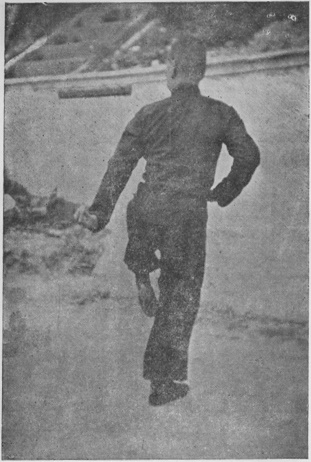
功用:
Application:
世有連環脚者,其勢速且難防,提前步以消來勢,抅手而下,以取其腿是雙重之法,惟勿使過後,以待下式展之開。
The opponent attacks with a series of continuous kicks, which is fast and difficult to defend against. I lift my left foot to dissipate his incoming attack while sending a hooking hand downward to catch his leg, a twofold method. The hooking hand must not go too far to the rear in order to make use of it in the following technique.
第二十式:提腿反提刁
Posture 20: LIFTED LEG, REVERSE LIFTING HOOK
說明:
Explanation:
步與上式同,後手不動,前手由下反行而上,其手勿挑之過高。
With your stance not changing and your right hand not moving, your left hand goes upward from below [i.e. from left to right], though should not go too high. See photo 20:
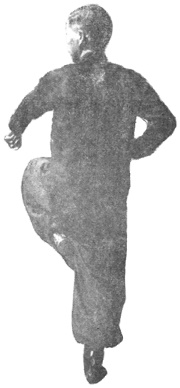
功用:
Application:
攻吾者用連環腿,我守者亦當以連環之法破之,使不得逞,此法與第十九式實為連繫,一落一上,乃對彼去此來之法。
The opponent is attacking me using a series of continuous kicks, so I defend by using a series of continuous blocks to prevent him from reaching me. This technique is a continuation from the previous technique, that one involving the hand lowering into place, this one involving the hand rising into place, a method of sending out one thing and bringing back another.
第二十一式:馬式右劈軋
Posture 21: HORSE-RIDING STANCE, RIGHT CRUSHING CHOP
說明:
Explanation:
放下獨立之脚,左手向前刁去,右脚進前一步,偷入敵前鋒,右拳向敵頸部劈下,偷入之步,同時施以反彈之法,使其上下牽制。
Your left foot comes down, your left hand hooking away in front, and your right foot advances a step, sneaking behind the opponent’s front leg, as your right fist chops down toward his neck. When your right foot steps behind his leg, it also does a reverse snapping action to it, thereby giving you control over both his upper body and lower body. See photo 21:

功用:
Application:
反彈卽從後彈出者是也,加以劈頂之勢,則全局為吾把握矣,惟吾步深入,須防下部被突擊,到此境地不容猶豫,毋授敵以𨻶!
With the reverse snapping to the back of his leg and the chop to the back of his head, the whole situation is thus under my control. When I step behind his leg, I have to guard my lower area against sudden attack. There should be no hesitation in this moment, giving the opponent no opportunity to exploit.
第二十二式:扭步左黏肘
Posture 22: TWISTING STANCE, LEFT STICKY ELBOW
說明:
Explanation:
從騎馬式,向右一扭以成坐盤式,右手順一刁之勢向後力牽,左手曲肘,朝上將臂肘托起。
Twist to the right to make a sitting-twisted stance as your right hand hooks away, forcefully dragging to the rear, and your left forearm props up from below with the elbow bent. See photo 22:
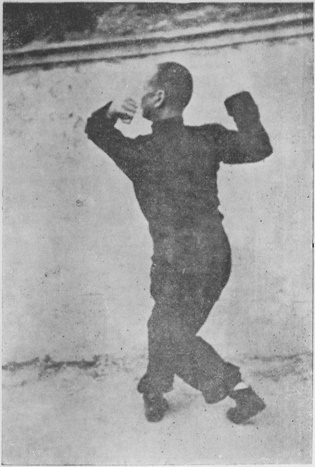
功用:
Application:
扭步乃乘勢,黏肘則順形,拳法中能利用形勢者謂神着,其肘直吾以曲制之,其勢正吾以側而攻之,因形度勢,判別虛實,乘機取利,則成敗之數立判。
I twist my stance to take advantage of the situation and it is the “sticky elbow” technique that happens to go along with the posture. In boxing arts, when you are taking advantage of your circumstances, it is said that you are performing “magic tricks”. The opponent’s elbow is directly in front of me, so I bend my own to control it, and since his stance is facing me, I therefore attack from the side. I act according to the position and situation, distinguishing between emptiness and fullness, seizing the opportunity to gain the advantage, and thus I am able to reckon the odds of success or failure.
第二十三式:登山左拐肘
Posture 23: MOUNTAIN-CLIMBING STANCE, LEFT PROPPING ELBOW
說明:
Explanation:
將坐盤之法解去,左步邁開進前為登山式,托起之肘沉下放平,就進馬之便,從脅下直撞而入。
Your left foot steps forward to make a mountain-climbing stance as your left elbow sinks down and goes across to smash the opponent’s ribs. See photo 23:

功用:
Application:
黏肘被對方橫肘沉下,直壓吾手,此時兩身接近,勝敗在此一舉,吾須犯險以貼靠之法迫之,將托上之肘橫撞,斯法雖險,然善用者,反能以之化險為夷也。
My sticky elbow has been pressed down by the opponent’s elbow. Our bodies are already very close in this position, and thus there is a thin line between victory and defeat, but I must take a chance and crowd in even further to now use my elbow to smash across. This method is somewhat risky, but those who are good at applying it can transform danger into safety.
第二十四:登山右斜掌
Posture 24: MOUNTAIN-CLIMBING STANCE, RIGHT DIAGONAL PALM
說明:
Explanation:
步與上式同,右掌向斜面揷出,與右手之曲肘成一直線。
Without changing your stance, your right palm charges out diagonally, making a line with your bent right [left] arm. See photo 24:

功用:
Application:
此法由正面移向側面,我欲待轉移方向,惟環境所不許,迫得側馬偏身應戰,拐肘旣為所卸,苟其從卸脫之時早懷反攻者,則我側面當受此威脅矣,故宜卽以順步之法以資抵禦,亦可暫救危險也。
This technique is for dealing with a shift of attention from the front to the side. I want to shift my stance, but there is no time, and so I am forced to respond to the opponent from a sideways position. He has dispelled my propping elbow and now seeks to counterattack before I can react, and thus I am now faced with a threat coming from the side rather than in front of me. I ought to align my stance with his position in order to better defend, but I can use this technique as a temporary means of rescuing myself from danger.
第二十五式:馬式正補捶
Posture 25: HORSE-RIDING STANCE, FORWARD FILLING PUNCH
說明:
Explanation:
此為由西返東,再由東而西之轉點,由登山而轉騎馬式,右掌撥開敵手,用補捶以塡其𨻶。
This posture finishes the second line of the set, in which you have been traveling west to east, after which you will switch to traveling from east to west. Switch to a horse-riding stance as your right palm deflects the opponent’s hand and your left fist performs a filling punch to fill the resulting gap. See photo 25:
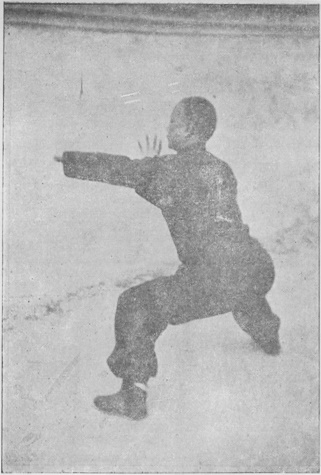
功用:
Application:
由側而正,由正反側,拳無所謂正與側,惟順其勢而已!揷掌之法乃應急之需,然此法實補揷掌之不足,是故螳螂拳法,多揷掌之後,卽以補捶,是塡其卸也。
To the side, then forward. Forward, then to the side. These things should not matter, for all that is important is to act in accordance with the situation. The charging palm was an emergency move, but this technique will now make up for its insufficiency. It is common in Mantis Boxing for a charging palm to be followed by a filling punch, filling in the gap that has been made.
第二十六式:雙刁左揪腿
Posture 26: DOUBLE HOOKING, LEFT SCOOPING KICK
說明:
Explanation:
由騎馬式轉向右方刁手,左刁再沿臂上抅出,同時左腿如七星步法向左揪去,使上下相反以擊敵重心。
Turn to the right with your right hand hooking, then send your left hand over your right arm hooking away [to the left] as your left foot goes out with a scooping kick [to the right], putting you into a position similar to a big-dipper stance. With your upper body and lower body acting in opposite directions, the opponent’s balance is attacked. See photo 26:
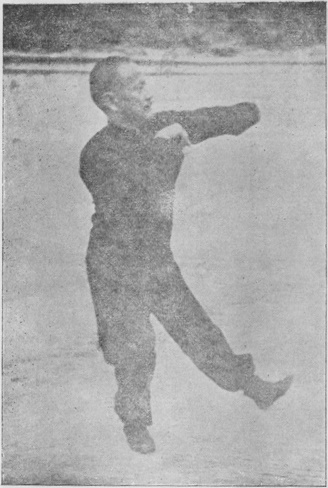
功用:
Application:
揪腿之法無異是前彈腿法,但彈則暗偷而用,揪腿則從正面明入,雖為敵所防,惟吾依法而用,是其分別處也,然手脚不能先後,亦不能遲疑,招之之法,可指腿而擊具上,則可解斯危。
A scooping kick is similar to a forward snapping kick, but whereas a snapping kick sneaks in with subtlety, a scooping kick is more obvious. This means the opponent would have the ability to defend against it, and so I must rely on complementing it with a different attack. The hand and foot must not move sequentially or with any hesitation. This technique involves kicking below while striking above in order to prevent it from being foiled.
第二十七式:雙刁右揪腿
Posture 27: DOUBLE HOOKING, RIGHT SCOOPING KICK
說明:
Explanation:
循左揪之勢以左手刁之,右手沿上抅出,同時以右七星脚向左揪去,與上式同一法門,所別者左右而已。
Continue from the left scooping kick by hooking toward the left with your left hand, then send your right hand [over your left arm] hooking away [to the right] as your right foot goes out with a scooping kick [to the left], again putting you into a position similar to a big-dipper stance. This is the same technique as in the previous posture, except with left and right reversed. See photo 27:

功用:
Application:
原則上與左翼相同,但左揪被提腿所消,我卽連續以右揪進擊,使敵無喘息及提備機會
This is the same technique as the left scooping kick. The opponent evaded my kick by lifting his leg, so I immediately continue by advancing with a right scooping kick, giving him no respite and no chance to defend this time.
第二十八式:跨虎雙捆手
Posture 28: SITTING-TIGER STANCE, DOUBLE SNARING HANDS
說明:
Explanation:
先提前腿,以使全身躍進,凡躍跳過高,着地處,以虛式為宜,故撲下之時為左跨虎式,雙手如捕蟬之法,從上封下以封敵手。
Your right leg lifts and your body leaps upward and forward, pouncing into a left sitting-tiger stance as your hands make the “catching a cicada” position, coming down from above to seal off the opponent’s arm. See photo 28:
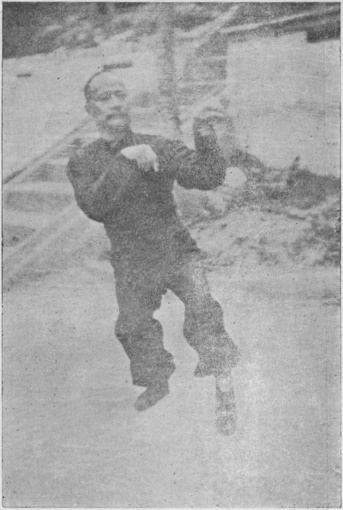
功用:
Application:
騰空撲下其勢固猛,加以雙綑復何患封之不牢耶!當我以上下夾擊攻敵之時,彼以法解救之後,乘吾中路空虛之際,施以中央攻法,吾便以騰起之勢,卸去目標,繼撲下而用雙綑緊扣其手。
The action of leaping up and pouncing down has a definite fierceness, making the double snaring that much more secure. When I attack the opponent with the pincering effect from my upper body and lower body, he finds a means of escape and then takes advantage of the gap in between by attacking my middle area, so I leap up to confuse his targeting, then pounce down with double snaring hands to tightly seal off his arm.
第二十九式:踢腿刁取眼
Posture 29: KICK, JAB TO THE EYES
說明:
Explanation:
先以左刁手抅去敵取吾睛之手,提前步縱身直往,右腿以撩陰之法踢出,右手以两指取睛,同線同出,使難躱避。
First your left hand hooks away the opponent’s hand attacking your eyes, then your left foot lifts and you hop up, your right leg kicking out with a raising kick to his groin, your right hand doing a two-fingered jab to his eyes. Your jab and kick go out in unison, making it difficult for him to defend against. See photo 29:
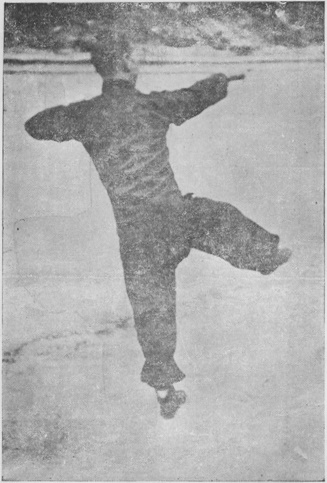
功用:
Application:
抹眉而啄睛不祗難用,而且難練,求能以一線齊出,並能集其全力者不易一見,此是險着也,啄睛使人盲其目,加以撩陰一脚性命可虞,練技旨在明其用法耳!,愼毋輕於一試。
Jabbing the eyes is not only difficult to apply, it is difficult to train in the first place, and to perform it in unison with another action means that it will not be easy to put your full power into it. This is a dangerous technique, for it could potentially blind someone, and the addition of the kick to the groin could potentially kill. This technique has to be practiced in order to understand how to apply it, but do not try it out rashly.
第三十式:提腿相擊掌
Posture 30: LIFTING LEG, STRIKING THE PALMS TOGETHER
說明:
Explanation:
上式踢出之脚收囘而成獨立式,左掌迎敵襲我之掌,我啄睛之手立卽抽囘,成正側之勢而互擊敵掌。
Your right foot withdraws to make a one-legged stance as your left palm connects to the opponent’s attacking palm and your right palm immediately whips back, your palms striking against each other with his palm in between. See photo 30:

功用:
Application:
我旣騰身而起,重心當隨之而離,若敵突由我左方面部一掌拍來,我卽以左手迎而托之,復抽囘右手使與左手平衡,藉互擊之力使夾在當中之敵手蒙其損害矣。
When I hop in the previous technique, my balance at that moment is at risk. The opponent suddenly sends a palm to slap to the left side of my face, so I use my left hand to prop it up and whip back my right hand to my left hand, forcefully striking them together, functioning as pincers to injure him [as well as helping to stabilize the posture, especially in tandem with the withdrawing leg].
第三十一式:刁手反衝爪
Posture 31: HOOKING HAND, REVERSE THRUSTING CLAW
說明:
Explanation:
左手刁開來拳,落下前脚為登山式,右手以刁內形狀,用腕尖骨沿左手之下向其肋內頂去。
Your left hand hooks away an incoming fist as your right leg comes down to make a mountain-climbing stance and your right hand goes out from below your left hand, making an inward pointing hooking hand, and does a wrist strike to the opponent’s ribs. See photo 31:
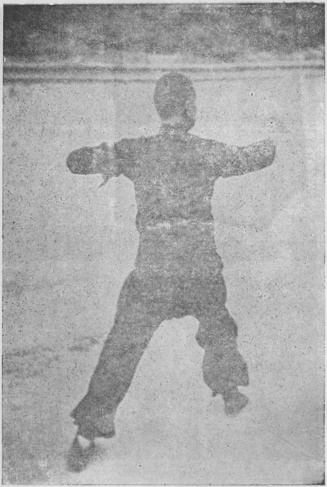
功用:
Application:
肺腑乃八打之一,惟範圍甚小,倘以拳擊之則無異隔靴搔癢,以指揷之似感力之不足,故而二者俱不用,改以反刁手之尖形,利其小而着力也。
The lungs under the upper ribs are one of the “eight allowable targets”. However, because they are positioned in a very cramped area, the impact from a fist will be too dispersed on the surface, and if you instead try to poke through with a finger, I fear it will be beyond your ability. Since both of these options are not as useful, instead choose to employ the wrist strike of a reverse hooking hand in order to use the smallest amount of effort and yet get the greatest penetrative impact.
第三十二式:拼腿上圈捶
Posture 32: LEGS TOGETHER, RISE UP, SWINGING PUNCH
說明:
Explanation:
因距離關係進一步過於迫近,不動式又離之太遠,故祗得將後脚移貼前脚再提右前脚以成獨立之勢,右拳由外反內成圈狀,將至定點處以左掌迎托之。
To close the distance without changing your overall position, your left foot simply shifts forward to be next to your right foot, and then your right foot lifts to make a one-legged stance as your right fist swings inward from the outside, your left hand propping against it upon reaching its final position. See photo 32:
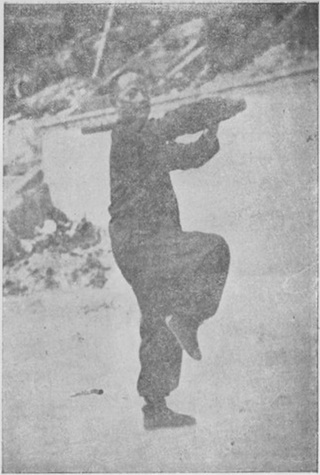
功用:
Application:
戰爭之道,爭戰時間,利用形勢,然後施以戰術,抑亦戰畧配以戰術也,為爭時間不克換步換形,迫得靠埋後脚,左掌沿右臂之上削下,以脫纏我之手,右拳從而圈內,取其太陽,雖為權宜之法,但無牽强之態也。
The way of warfare is to first get into the most advantageous position and then execute military tactics and strategy. Finding myself in a situation in which I cannot switch my feet or change my position, I have to rely on bringing my rear foot forward to close the distance, sending my left palm scraping downward along the top of my right arm to tear my right hand out of his grip, and then my right fist swings inward to attack his temple. This is a very convenient technique and nothing overly fancy.
第三十三式:提腿下截捶
Posture 33: LIFTING LEG, DOWNWARD INTERCEPTING FIST
說明:
Explanation:
與前式原步不變式,掌按肩膀,右臂貼身橫削而下,惟掌拳相擦之時,必拍然作響,此為螳螂拳之特處,考其用意乃互相增强力量。
With your stance not changing, your left palm goes to your right shoulder as your right arm cuts downward near your body, your palm and fist scraping against each other on the way, producing a slapping sound. This is a characteristic action in Mantis Boxing, the purpose being to increase power in both the palm and fist. See photo 33:
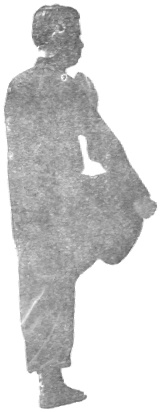
功用:
Application:
拳術之道跪計多端,有先以上擊然後反而打下者,彼虛此實,連環偷漏,法至難防,設有以窩肚捶法,向我突進一捶,吾卽提步削下,取雙重防禦以保不測。
There is a great variety of trickery in boxing arts, for instance attacking above and then striking below, a fake action followed by a real action, a continuous unpredictability that makes it difficult for the opponent to guard himself against. When he suddenly attacks me with a punch to the belly, I both lift my leg up and cut downward with my fist, a dual action [triple including the palm guarding at the shoulder] to better cover myself against any surprises.
第三十四式:提腿上挑捶
Posture 34: LIFTED LEG, CARRYING FIST
說明:
Explanation:
步同前法,將削下之橫捶反挑而上,但勿過肩。
With your stance still not changing, reverse your right fist into carrying upward, but no higher than shoulder height. See photo 34:
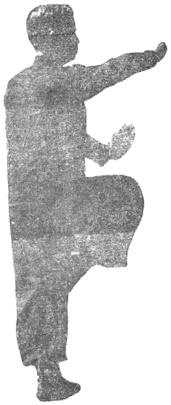
功用:
Application:
與上式實為聯繫之手法,劈下攔去窩肚捶反挑而消上打之手,所謂低攔上挑是也,其中上連進,則我相輔為用,若祗上打,此法亦善。
This and the previous posture actually form a continuous technique, chopping down to block away a punch to my belly, then carrying upward to dispel a strike to my upper area, the whole thing referred to as “low block, upward carry”. For continuous attacks to the middle area and upper area, these two actions complement each other well, though if defending only against a strike to the upper area, this carrying action on its own is still just as superb.
三十五式:登山封齊掌
Posture 35: MOUNTAIN-CLIMBING STANCE, SEALING, EQUALIZING PALM
說明:
Explanation:
左手從內穿出,順而封閉其手,右掌平橫,直削而入,步亦由獨立式而落為登山式。
Your left hand threads out from inside to seal off the opponent’s incoming hand, then your right palm cuts straight out with the palm sideways as your right foot comes down to make a mountain-climbing stance. See photo 35:

功用:
Application:
掌有橫,齊,反,漏,切之別,然須因勢利導,橫而封擊勢所使也,用掌比拳為難,因其法至繁也。
Among palm techniques are the flinging palm, equalizing palm, backhanded palm, slipping palm, cutting palm, and so on, which have to be applied according to the situation, in this case striking with the palm sideways after sealing [the pulling back together with striking forward forming the equalizing]. Using palms is more difficult than using fists because palm techniques tend to be more complicated.
第三十六式:反封左措捶
Posture 36: REVERSE SEALING, LEFT TWISTING HIS FIST
說明:
Explanation:
仍如上拳登山式,橫出之掌被捉,我卽反而擒之,倒以反上,加左手於其上,力措其腕。
With your stance not changing, your attacking palm has been grabbed, so your right hand does a reverse grab and turns the opponent’s arm over, then your left hand presses upward on his hand to forcefully twist his wrist back. See photo 36:
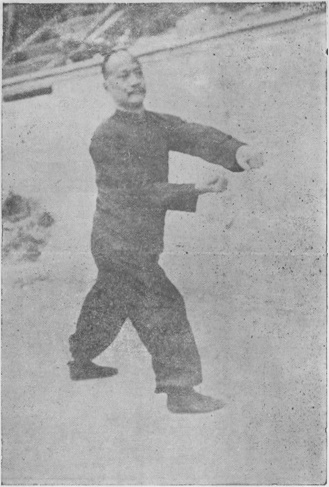
功用:
Application:
之經之截脈,點穴,纏筋,措骨為神妙,措骨者反其順而逆之,反封者旣為所封,立反封之,提而從左方措其腕骨。
Among the ingenious methods of attacking vessels and acupoints, and twisting sinews and bones, “twisting bones” means to take the opponent’s body from a natural position to an uncomfortable position. “Reverse sealing” means to immediately seal off the opponent’s hand as soon as he is sealing yours. Your other hand then lifts his hand and twists his wrist back.
第三十七式:迎封右措捶
Posture 37: BLOCK & SEAL, RIGHT TWISTING HIS FIST
說明:
Explanation:
仍用右登山式,以措捶之法纏其右手,對方反以左拳劈我,則逆而托之,加右手轉左措之,法與上式畧同
With your stance still not changing and your hands still twisting back the opponent’s right hand, he turns around [to the left] and uses his left fist to chop to your head. Letting go of his right hand, your left hand props up, [grabs, and turns his arm over,] then your right hand twists his wrist back, the technique the same as in the previous posture. See photo 37:
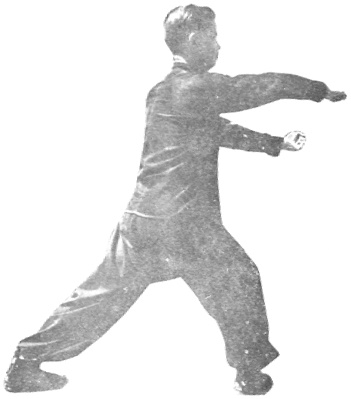
功用:
Application:
纏絲之法,為拳家之秘,惟得傳者推而行之,亦何難乎?左右措捶與纏絲法實殊途同歸耳。
Methods of “twisting silk” are a special secret of boxing arts, for they are difficult to learn and difficult to practice. “Twisting the fist” and “twisting silk” are not entirely the same thing, but they are different means to the same end.
第三十八式:掛手頂臍捶
Posture 38: HANGING HAND, PUNCH TO THE NAVEL
說明:
Explanation:
前右步猛向地力踏,使聲雄而壯復進左脚以成登山步其勢,左手從下橫架而上,右捶反由下衝上,力撞其臍部。
Your right foot fiercely stomps down, producing an intimidating sound, then your left foot advances to make a left mountain-climbing stance as your left fist goes upward from below to block with the forearm placed horizontally and your right fist thrusts upward from below to forcefully smash the opponent’s belly. See photo 38:

功用:
Application:
掛手者向上橫攔是也,螳螂拳多掛手統捶,然此一着則捨統捶不用,反拳抽上取其肚臍,順流拋撞而上,掛而拋撞是剛着也。
The “hanging hand” is an upward block with the forearm placed across. In Mantis Boxing, a hanging hand is typically accompanied by a thrust punch, but in this technique the thrust punch is replaced with the fist turned over and whipping out upward toward the opponent’s navel area, a flowing action of hurling out a strike. To block upward with a hanging hand and hurl a strike to smash the opponent makes this a technique of hardness.
第三十九式:呑塌右扇風
Posture 39: GULP & SINK STANCE, RIGHT FANNING
說明:
Explanation:
吞塌式與反登山式相同,惟用意有別,呑塌步橫扣敵馬,扇風手兩手曲指如鈎之狀,下封其手,上取耳朶,脚扣其馬,發以相反之力,吾功成下矣。
The “gulp & sink stance” looks similar to a reverse mountain-climbing stance, but has a different purpose, your “gulping” foot moving across to trap the opponent’s front leg. The “fanning” then involves both hands forming hooks: the lower hand sealing off the opponent’s hand, the upper hand attacking his ear. As your right foot traps his front leg, your hands express power in the opposite direction, thus making him fall. See photo 39:
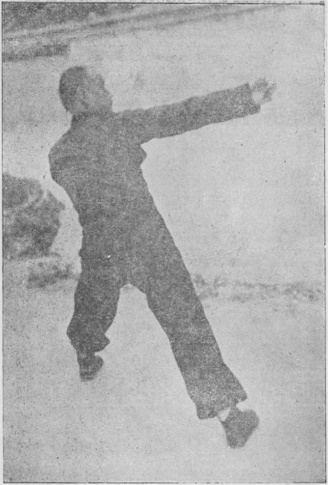
功用:
Application:
呑而塌之,呑者入其步,塌者跌之是也,與揪腿法大同小異,扇風者封擊耳朶之謂。
To “gulp” is to invade the space of the opponent’s stance. To “sink” is to then lower into your own. The position looks similar to a scooping kick. “Fanning” is a sealing strike to his ear.
第四十式:呑塌左扇風
Posture 40: GULP & SINK STANCE, LEFT FANNING
說明:
Explanation:
是式為再由西復東之起點,先踏右步拍貼左步,替左步偷入先右封再以左手用扇風法出之。
Turn around where are you, switching from facing west to facing east, first stomping your right next to your left foot and then stepping in with your left foot as your right hand seals off and your left hand goes out with a fanning action. See photo 40:
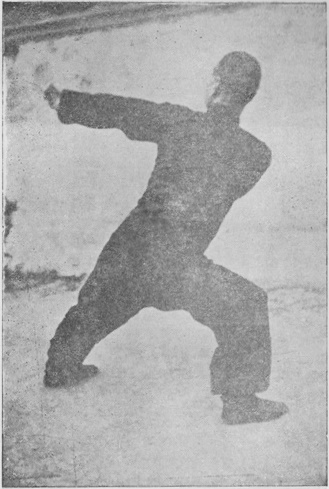
功用:
Application:
踏步翻身之法,較勝於進步換形,以利其簡快也,乘一踏之勢隨而偷入,手足並加,牽而倒之,亦牽纏倒掛,偷彈封閉之妙也。
This method of turning and stomping is better than advancing by switching feet, for it is simpler and quicker. Stomp and step in, hands and feet acting in unison. This technique has the marvels of tangling up the opponent and making him topple, doing a snapping action below while doing a sealing action above.
第四十一式:呑塌右扇風
Posture 41: GULP & SINK STANCE, RIGHT FANNING
說明:
Explanation:
以呑塌步,再進一步,亦成呑塌步,反手而封,進亦扇風,務使綿亘不絕,進而反身,反身而再進,前後左右連續之扇風,相機而行。
Advance a step [with your right foot] to make another gulp & sink stance as your right hand seals in the opposite direction, performing advancing with fanning. These three postures [39–41] should be done in an unbroken flow: advancing, turning, advancing, while fanning forward with your right hand, to the rear with your left hand, then forward with your right hand, all in accordance with the situation. See photo 41:
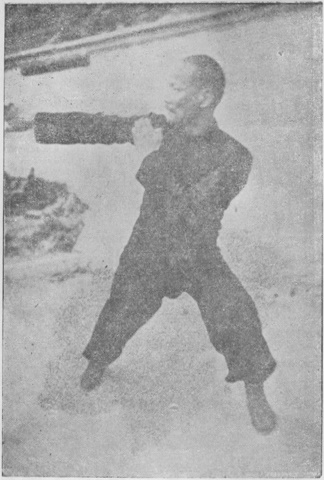
功用:
Application:
螳螂拳法論曰,不招不架實是能家,若還招架,眞是空家,本是一扇風耳!若再其一,反引而再,而三,連續不斷。
Mantis Boxing uses this maxim: “One who never blocks has mastered the art. One who is constantly blocking has mastered nothing.” This neatly describes the fanning attacks to the opponent’s ears, done a first time, a second time, then a third time, all as a continuous flow.
第四十二式:引針右腰斬
Posture 42: DRAWING THE NEEDLE, RIGHT SLICING THROUGH THE WAIST
說明:
Explanation:
由扇風之手,穿而進之,引手封之,進左步鈎其足,反掌切出,抅封纏斬,此之謂也。
Your left hand threads forward to draw in and seal off, then your left foot advances to hook around the opponent’s foot and your right palm slices out. Grab and seal, then coil and slice. See photo 42:
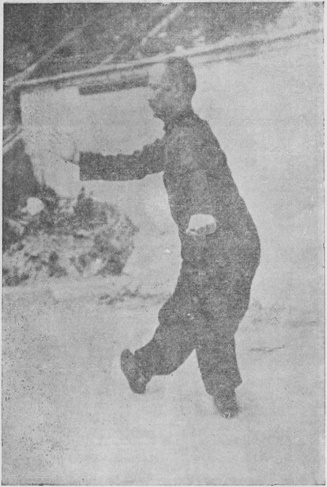
功用:
Application:
引針者言其小也,然每事物俱從小做大,由引針之小可致腰斬之害,引針者穿手而復封,封而入步,入步然後近其腰而斬之,腰乃中心所寄,設為所斬,其不倒者幾希。
To “draw a needle” sounds like such a small thing, but big things come from small things. The small action of “drawing a needle” can lead to “slicing through the waist”. The “drawing” is the hand threading through and then sealing off, which is followed by stepping in and slicing to the opponent’s waist. The waist is the center of all actions, and so slicing to his waist is sure to make his structure collapse.
第四十三式:登山左圈捶
Posture 43: MOUNTAIN-CLIMBING STANCE, LEFT SWINGING PUNCH
說明:
Explanation:
從七星步,落而轉登山式,左拳由外橫圈返內,橫打太陽穴。
Come down forward from your big-dipper stance to make a mountain-climbing stance as your left fist swings across inward from the outside to strike to the opponent’s temple. See photo 43:
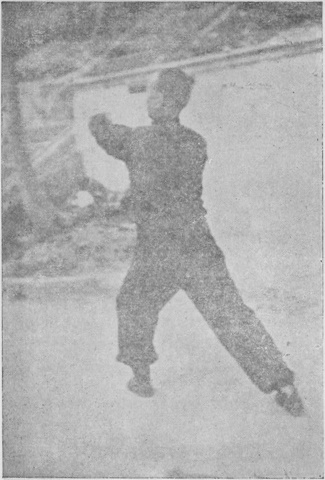
功用:
Application:
太陽者乃八不打之首,亦為人之首要,圈而打之,勢速而盡,惟其手高打低首避之容易卸去矣。
The temple is the first of the “eight forbidden targets”, being a vital area on the body. The technique of swinging across to strike this area is fast and powerful. However, it is easy to deal with it simply by ducking out of the way.
第四十四式:登山右崩捶
Posture 44: MOUNTAIN-CLIMBING STANCE, RIGHT [LEFT] AVALANCHE PUNCH
說明:
Explanation:
與上登山式不變,由外圈內之拳,反由內而外,封而崩之。
With your stance not changing, your left fist goes inward from outside as your right hand performs a sealing action, and then your left fist goes outward from inside, performing an avalanche punch. See photo 44:

功用:
Application:
崩捶與挫捶若以定式觀之實無二致,惟崩捶則由上打下,挫捶由下衝上,崩捶利於出脚,挫捶利進迫,其未來之趨勢不同也。
An avalanche punch and a subduing punch both have the same final position, but the avalanche punch strikes downward from above whereas the subduing punch thrusts upward from below. The avalanche punch benefits from stepping forward and the subduing punch benefits from crowding the opponent’s space, and so the outcome of each is not the same.
第四十伍式:七星左刁手
Posture 45: BIG-DIPPER STANCE, LEFT HOOKING HAND
說明:
Explanation:
登山式反坐後腿,前腿往後一仰則七星勢成矣,右手收貼腰,左手向前刁出。
Sit back from your mountain-climbing stance, your left foot drawing back to make a big-dipper stance, as your right hand withdraws to your waist and your left hand goes forward with a hooking action. See photo 45:
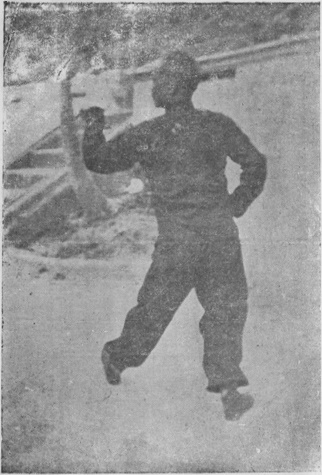
功用:
Application:
拳擊之戰與槍炮之戰,其分別處在距離,以登山式移後作七星式,一前一後約差尺餘,假若為敵迫近,無法可解之時,足退而讓之之妙法也。
Fighting with fists is very different from combat involving guns. Going from the mountain-climbing stance to the big-dipper stance shifts you back more than a full foot away. If the opponent is closing in and there is no time to dispel his attack, this is an ingenious means of withdrawing to make room for him.
第四十六式:七星右補捶
Posture 46: BIG-DIPPER STANCE, RIGHT FILLING PUNCH
說明:
Explanation:
左前七星步,進一步為右前七星步,其捶法與順步補捶相同。
Your right foot advances to make a right big-dipper stance as you perform the same punching technique as in MOUNTAIN-CLIMBING STANCE, RIGHT FILLING PUNCH [Postures 5 and 15]. See photo 46:
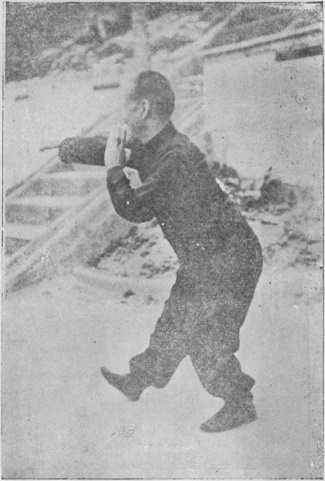
功用:
Application:
七星式為螳螂常步,因其虛實各半,進退自如,故多用之,刁手為卸讓之法,捕捶亦塡其缺漏而已。
The big-dipper stance is a common stance in Mantis Boxing. It is used frequently because it can be used equally for both fake and real techniques, and facilitates smooth advancing and retreating. The hooking hand in the previous technique took aside the threat from the opponent and now the filling punch fills in the resulting gap.
第四十七式:跨虎捕蟬式
Posture 47: SITTING-TIGER STANCE, CATCHING A CICADA
說明:
Explanation:
由七星步踏下,反身而補蟬,與第三式相同,惟換步與反身有别耳。
From the big-dipper stance, your right foot stomps as you turn around and perform a “catching a cicada” action. It is the same as in Posture 3, except that this time you are switching feet by turning around. See photo 47:

功用:
Application:
倘為敵從後追來,則反封之,若捕蟬之狀,起脚閉之使難躱避至此全拳已完,抑亦返囘起點之處矣。
If an opponent rushes in from behind me, I turn around and seal off his attack in the manner of “catching a cicada”. In this position, I can also lift my foot to kick him, which he will find difficult to evade. This posture also serves to complete the entire set, having returned to the starting place.
–
三十五年來對螳螂拳之認識
SOMETHING FROM MY THIRTY-FIVE YEARS OF MANTIS BOXING KNOWLEDGE
[This piece was added to a later edition of the book.]
中國拳術多有偏重之弊,有崇柔手,當變化者,有善短打,求硬拚者,有長橋大馬,拋手遠擊者,有集全力於下三路專以掃膛為能事者,有穩紮穩打,先求能守,然後始及於攻者,有貼身靠步以求跌撲對方者不一而足,實為代表中國拳術某一長處,唯螳螂拳則有綜合各種長處之妙,如(引針腰斬)(左右獻桃)(美女過橋)(雙匿爪)(迎面掌)(左右穿梭)等俱為善變化而屬柔軟如曲水浸紗,隨波逐浪之連綿不絕者之柔手也。(如叠肘硬拱)(扭身黏肘)(順步拐肘)(摔捋硬崩)纏措並加之剛而短打之手豈非為短打硬拚之法歟!
如(左右跨步搶進)(迎面直統)(十字直統)(進退翻車)(高低轆轤)等手法非為長攻遠取者耶!
如(揪腿)(穿掌蹬𨁏)(穿捶蹬𨁏)(封手蹬𨁏)(叠肘蹬𨁏)(吞塌扇風)(封手扑腿)(連環掃腿)等俱為致力於下三路之手步腿法也。
如(左右躱剛)(撤步挑掌)等斯乃先求能守始及於攻之法矣。
如(入環仰膀)(繞手滾膀)(封手雙撞)等俱為貼身靠步跌撲對方之法也。
如是而論螳螂拳實為集合各家之所長於一身矣,然同但知螳螂拳為快速之拳術,練時祗知求快速美觀為能事,若持此作根據,則徒得斯拳之外貌耳!正如俗謂:(銀樣腊槍頭)中看不中用也。
譬喻:學習珠算(打算盤)先嚴守本位,認淸變化,心算,口訣,俱已純熟方可打迅速之珠算,否則必錯誤百出矣。
練拳亦然,先能使每動作之身手腿步皆有正確之認識,默誌於心,而按式操練,至純熟後始續漸增加其速度,此為正確之法,是故螳螂拳經有云:(出手快,盤式慢。)之語,進而出手踢腿俱着着幻出假想敵於面前,使手足不致無的放矢也,行之有素便是練螳螂拳眞確之途經矣,茲以本書缺少,文稿一則,乃臨時寫此以塡空白,經驗云乎哉。
Chinese boxing arts often have the drawback of emphasizing a particular aspect over others:
Some focus on using softness and adaptability, intent on yielding like water or absorbing like gauze, then follow up by drowning the opponent in endless waves. (Some example techniques of this are: DRAWING THE NEEDLE, SLICING THROUGH THE WAIST; LEFT & RIGHT OFFERING A PEACH; BEAUTIFUL WOMAN CROSSES THE BRIDGE; DOUBLE HIDDEN CLAWS; PALM STRIKE TO THE FACE; LEFT & RIGHT SENDING THE SHUTTLE THROUGH)
Some focus on increasing the pressure through using short-range techniques, seeking to make the opponent panic. (Examples: FOLDING IN THE ELBOWS TO MAKE A STRONG ARCH; TWISTING STANCE, STICKY ELBOW; STEP FORWARD, PROPPING ELBOW; THROWING TO THE SIDE, POWERFUL AVALANCHE)
Some focus on long reach and large stances, throwing out the hands to strike far away. (LUNGING STEP, SUDDEN ATTACK; THRUST PUNCH TO THE FACE; CROSS-SHAPED THRUST PUNCH; ADVANCING & RETREATING WHEELING TECHNIQUE; HIGH & LOW WINCHING)
Some focus on concentrating all of one’s power in the lower body to sweep out the opponent’s legs. (SCOOPING KICK; THREADING PALM, PAVING KICK; THREADING FIST, PAVING KICK; SEALING HANDS, PAVING KICK; PILING ELBOW, PAVING KICK; GULP & SINK STANCE, FANNING; SEALING HANDS, REACHING-LEG STANCE; CONTINUOUS SWEEPING LEGS)
Some focus on having a solid defensive position as a means to a solid offensive capacity, first seeking to be able to defend in order to then be able to attack. (LEFT & RIGHT DODGING HARDNESS; WITHDRAWING STEP, CARRYING PALMS)
Some focus on stepping in to crowd the opponent in order to pounce on him. (KNEELING STANCE, PRESSING FOREARM; COILING HAND, ROLLING FOREARM; SEALING HANDS, DOUBLE RUSHING PUNCHES)
Each Chinese boxing art indeed has its particular strong points, but Mantis Boxing has the ingenuity of combining a variety of strong points to have the best qualities of all the other arts. Most people think of Mantis Boxing simply as a high-speed boxing art, but if practitioners seek only to be fast and make the movements pretty, they will only achieve the outward appearance of the art. The result will be just like this line from Romance of the Western Chamber [act 4, scene 2]: “Oh, you’re just a spear tip that looks like it’s made of silver but is really only made of wax.” It may be pleasing to the eye, but it is useless.
For an analogy, learning to use an abacus first requires a strict adherence to a standard method. When you have a thorough understanding of how the beads are to be moved, and you are skillful at the mental arithmetic and verbal mnemonics, you will then be able to make calculations quickly, but otherwise your reckonings will be full of errors. This kind of process is also true in practicing boxing arts.
First focus on understanding the correct way to use your body, hands, legs, and steps for every movement, then once you have become skillful at the movements, you may gradually increase their speed. This method of prioritizing precision is what is meant by the Mantis Boxing maxim of “fast hands, slow set”. Then proceed to imagining an opponent in front of you with every technique you perform, whether attacking with your hands or kicking with your legs, so that your hands and feet are not just lashing out randomly. This is the authentic path toward developing a solid foundation in Mantis Boxing.
(I felt that there was something lacking from this book, so I have now provisionally added this item to fill the void, a few words about what I have learned through experience.)
– – –
[View an original Chinese edition of Avalanche Steps Boxing Set (Revised), provided by the Ravenswood Academy.]
–
–
–
